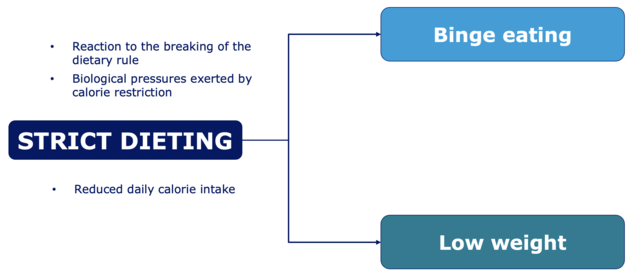Eating Disorders
Dietary Restraint and Dietary Restriction in Eating Disorders
Adverse effects, maintenance mechanisms, and strategies to address them.
Posted November 1, 2021 Reviewed by Jessica Schrader
Key points
- Most people with eating disorders diet to an extreme extent.
- Dietary restraint is the attempt to restrict what one eats, while dietary restriction is undereating in the physiological sense.
- Strict dieting should be addressed in treatment, as it can cause major adverse effects and maintain the eating disorder.
Most people with eating disorders, except for those with binge-eating disorder, diet to an extreme extent. Rather than adopting general guidelines about how they should eat, they set themselves multiple, demanding, and highly specific dietary rules to limit what they eat. This "strict diet" has three main characteristics:
- It is persistent.
- It has extreme goals (i.e., it is characterized by the adoption of several dietary rules requiring continuous vigilance and a constant commitment).
- it is inflexible (i.e., it is characterized by the adoption of rules that must always be followed to the letter).
Such a rigid attitude to dieting usually stems from a desire to lose weight or to prevent weight gain and "getting fat," in which case it is driven by the overvaluation of shape and weight, or by a need to maintain strict control over eating, in which case the culprit is the overvaluation of eating control per se.
It is important to distinguish two aspects of strict dieting, as both need to be addressed by the treatment:
- Dietary restraint (that is, attempting to restrict what one eats).
- Dietary restriction (that is, undereating in the physiological sense).
Dietary restraint
Dietary restraint is a term used to describe the attempt to restrict what one eats. While many people without an eating disorder adopt moderate and flexible dietary restraint to control their body weight and eating, those with an eating disorder self-impose dietary rules that are extreme and rigid.
We say that dietary restraint is "extreme" when there are many dietary rules that are demanding in nature and require continuous vigilance and that it is "rigid" when the highly specific self-imposed dietary rules must be followed to maintain a feeling of being in control. It is this type of dieting that encourages binge-eating episodes.
The extreme and rigid dietary rules that characterize dietary restraint typically include when (e.g., never before/after 6 p.m.), how much (e.g., less than 800 calories a day), and what to eat (e.g., only fruits and vegetables).
The dietary rules of people with eating disorders are often associated with various forms of food checking, the most common being the following:
- Repeatedly reading labels on the calorie composition of foods.
- Weighing food several times.
- Meticulously and repetitively planning the calories to be consumed during the day (or even week).
- Counting the number of times a mouthful of food is chewed.
- Checking what others eat (especially those who eat little).
- Asking others for reassurance about the quantity and/or quality of the food they are eating.
Dietary restriction
Dietary restriction is a term used to define true undereating in the biological sense. In these cases, the person loses weight and may become significantly underweight developing specific physical and psychosocial symptoms (see Table 1) caused by undernutrition. Some people with eating disorders say they do this because they are not hungry, but this is rarely true. Indeed, except in people with marked clinical depression, loss of appetite is seldom the main cause of food limitation, which instead is a goal to be actively pursued.

Strict dieting causes major adverse effects and maintains the eating disorder
Strict dieting can have the following major adverse effects:
- Concern about eating that affects concentration in many activities of daily life, such as studying, watching television, reading a book, and spending time with friends.
- Anticipatory anxiety every time one eats due to the fear of not being able to follow the extreme and inflexible dietary rules.
- Guilt when the dietary rules are broken.
- Interpersonal relationships can be affected because it makes it difficult to eat with others.
Strict dieting maintains the eating disorder through two main mechanisms (Figure 1):
- It may result in weight loss or may maintain the low weight. If dietary restraint is successful in producing persistent undereating, being underweight is an inevitable outcome.
- It is a major contributory factor to binge eating (objective or subjective). The adoption of extreme and inflexible dietary rules, as opposed to flexible dietary guidelines, together with a tendency to react in a negative and extreme manner to the almost inevitable occasions on which these rules are broken, often leads to a temporary abandonment of control over eating (e.g., an episode of objective or subjective binge eating); this may, in turn, be further promoted by the biological pressures exerted by calorie restriction.
Despite the negative consequences of strict dieting, most people with eating disorders do not see dietary rules and food checking as a problem but rather as a measure of their strength and willpower. They are an expression of their identity as "good dieters." If they see themselves failing at dieting, they believe that they are weak rather than because their dietary rules are too rigid and extreme. In those who binge eat, extreme dieting is generally one of the main means they use to compensate for a binge eating episode, while those who have been or are overweight see this type of dieting as perfectly reasonable.

Strict dieting needs to be addressed in the treatment
Both dietary restraint and dietary restriction need to be addressed in treatment because they impair and maintain the eating disorder. Enhanced cognitive behavior therapy (CBT-E), one of the recommended psychological treatments for eating disorders, tackle strict dieting with three steps.
The first step is to discover the reasons for dieting, paying particular attention to concerns about shape and weight, and helping the patients to see the adoption of extreme and rigid dietary rules as a problem, and deciding to address them actively. Patients are helped to analyze the perceived positive functions of dieting, its adverse effects, the mechanism by which it maintains the eating disorder, and the pros and cons of addressing it.
The second step, if the patients agree to address strict dieting, is using a twofold strategy: (i) indirectly, addressing the overvaluation of shape and weight with the Body Image module; and (ii) directly, using the Dietary Restraint module and the Underweight module (if indicated).
The third and final step is to help patients develop specific skills to minimize the risk of relapse to adopt dieting in the future.
References
Dalle Grave, R., & Calugi, S. (2020). Cognitive behavior therapy for adolescents with eating disorders. New York: Guilford Press.
Dalle Grave , R., & el Khazen, C. (2022). Cognitive behaviour therapy for eating disorders in young people: a parents' guide. London: Routledge.
Fairburn, C. G. (2008). Cognitive behavior therapy and eating disorders. New York: Guilford Press.
Fairburn, C. G. (2013). Overcoming binge eating, Second Edition. New York: Guilford Press.




